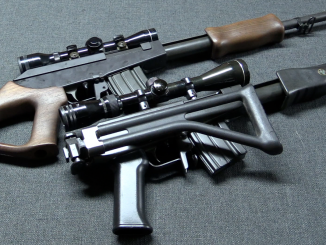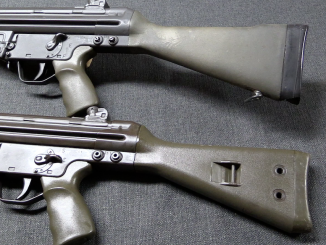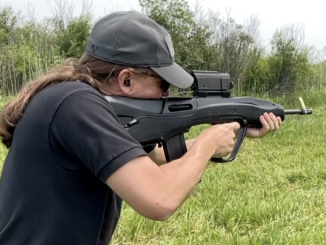During World War Two, the South African military used a lot of .303 caliber Bren guns. When 7.62mm NATO became the standard cartridge after the war, the Bren guns were put into storage, as converting them to the new rimless cartridge was a fairly complicated process. Instead, they purchased new FN- MAG machine guns, and supplemented them with conversion of Vickers and M1919 Browning guns (which were much simpler to do).
However, as the war in South West Africa (now Namibia) escalated, more guns were needed. The embargo in effect prevented purchase of MAGs (or their parts), and so a twofold plan was put into place. A new domestic machine gun went into development (this would become the SS-77), and the Bren guns in storage were converted to 7.62mm NATO. These Brent were a variety of models and in in widely varying condition. Where the British Bren gun conversion (the L4) was done after refurbishing the base guns to essentially factory new condition, the South Africans did not have the parts or facilities to do this sort of rebuilding. Instead, their Brens were essentially each hand fitted to fit the new parts to the different donor guns.
Mechanically, the conversion required new barrels, extractors, and magazine catch blocks. The barrels were made new by Lyttleton Engineering Works (LEW), and fitted with the sights, carry handles, and gas blocks taken from the original .303 barrels. The sights were not recalibrated for 7.62mm. The magazine locking blocks were designed a bit differently from the British L4 pattern. For magazines, the South Africans made their own straight 30-round mags, and also used standard R1A1 (FAL) 20-round rifle magazines. These did include some of the unique South African hybrid mags, with metric locking lugs and inch-type floorplates. New polymer furniture was also made, but only used on guns whose existing furniture was beyond repair.
The conversion program ran from 1972 until 1976, and it converted all of the South African stock of surplus Brens. The program was only somewhat successful, because of the mixed states of the base material. While some ran extremely well (as did the British L4 conversions), some were simply too worn to be reliable and problems like runaway triggers were not uncommon. In addition, the hand-fitted nature of the guns meant that as they were used in the field and required additional maintenance, they were not parts-interchangeable. Any further work on them also had to be hand-fitted – not a sustainable situation.
Many thanks to DSA for giving me access to the excellent example from their reference collection (as well as the L4 for comparison) to film for you!




I am surprised that a Mk1 Bren was made as late as 1944. I had thought that the Mk2 replaced them in construction much earlier than that.
I remember using the Bren Gun on patrol as part of the Namibian war.
As stated, not all the conversions were 100 % successful, meaning that you sometimes get a gun that were prone to jamming, especially in the sandy conditions. Our solution to the problem was to carry one or two bottles of oil with us.
When the gun would start jamming, we used to close the ejection port, pour about 200 ml oil in, re-mount the magazine and continue firing. I think we were very fortunate that the guns did not blow up, but it seems to stop the jamming for a few magazines.
Just go to show what stupid young men used to do.
Just a thought; but the trajectory of .303 Brit in yds is probably a close match to 7.62 NATO in meters.